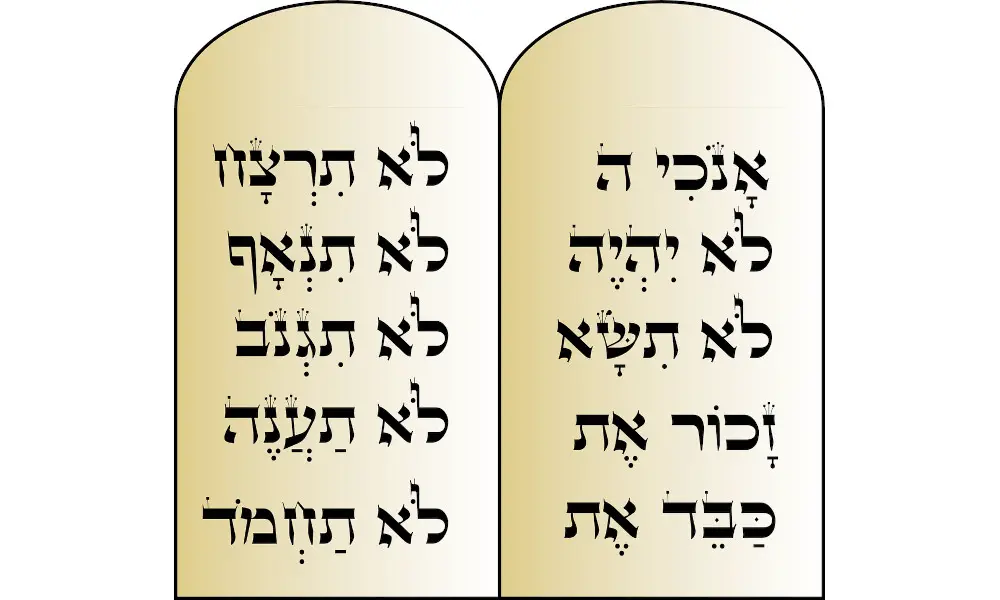The hot desert sun beat down on the Israelites as they gathered at the foot of Mount Sinai.
Moses had led them here, where God would deliver the stone tablets inscribed with the Ten Commandments. As the people waited in anticipation, Moses ascended the mountain to receive God’s sacred words.
After forty days and nights, Moses descended Mount Sinai carrying two stone tablets. He announced, “God has given me the Ten Commandments, His rules for righteous living.”
Following God’s instructions, skilled artisans constructed a golden chest—the Ark of the Covenant—to hold the stone tablets. When they finished, the priests carefully took the ark and placed inside it the stone tablets containing the Ten Commandments.
This Ark would lead and protect the Israelites on their journey to the Promised Land. It was a holy relic, representing God’s covenant with His people.
The story of the Ark only grows more intriguing from there. Over its long history, the relic would be lost, rediscovered, captured in battle, and recovered again.
Its secrets still fascinate us today…
The Ark of the Covenant: An Introduction

The Ark of the Covenant, also known as the Ark, is a revered religious symbol in both religious and historical contexts.
It was constructed during the time of Moses and played a central role in ancient Israelite worship.
The Ark was a sacred chest that held the tablets inscribed with the Ten Commandments, symbolizing the covenant between God and the Israelites.
What was the Ark of the Covenant?
The Ark of the Covenant was a rectangular chest made of acacia wood and overlaid with gold. It had a lid known as the Mercy Seat, adorned with two golden cherubim.
The Ark’s dimensions and intricate design were outlined in the Hebrew Bible, emphasizing its significance as a sacred object.
The Biblical Accounts of the Ark

The Hebrew Bible provides detailed accounts of the Ark’s construction, purpose, and the events associated with it.
It was primarily associated with the Tabernacle, the portable sanctuary of the Israelites during their wilderness journey.
The Ark represented the divine presence of God and was a focal point of worship and spiritual guidance for the Israelites.
The Construction and Design of the Ark
According to the instructions given to Moses, the Ark was built using acacia wood and covered in gold. It had rings on its sides through which poles were inserted for carrying.
The lid, the Mercy Seat, was adorned with golden cherubim facing each other, and it was from this seat that God communicated with the Israelites.
The Role of the Ark in Ancient Israelite Worship

The Ark held immense significance in ancient Israelite worship. It was kept in the Holy of Holies, the innermost sanctum of the Tabernacle and later the Temple in Jerusalem.
The Ark represented the presence of God and served as a focal point for prayers, offerings, and rituals conducted by the high priest.
The Journey of the Ark: From Moses to Solomon
The Ark accompanied the Israelites throughout their journey, leading them to the Promised Land.
It played a pivotal role in pivotal moments such as the crossing of the Jordan River and the destruction of the walls of Jericho.
The Ark was eventually housed in the Temple built by King Solomon in Jerusalem.
The Disappearance of the Ark: What Happened to It?
The fate of the Ark of the Covenant remains a mystery. Various theories and speculations surround its disappearance.
The Hebrew Bible mentions the Ark being captured by the Philistines but later returned to the Israelites.
However, after the destruction of the Temple by the Babylonians, there is no definitive mention of the Ark’s whereabouts.
The Ark of the Covenant in Mythology and Pop Culture
The Ark’s mysterious nature has captivated the imagination of people throughout history. It has found its way into mythology, legends, and popular culture.
References to the Ark can be found in ancient Ethiopian traditions, the story of Indiana Jones in “Raiders of the Lost Ark,” and other fictional works, adding to the intrigue surrounding the relic.
Unraveling the Ark’s Mysteries: Theories and Speculations
Numerous theories and speculations attempt to explain the fate of the Ark. Some suggest it was hidden or destroyed, while others propose it was taken to Ethiopia for safekeeping.
Archaeologists, historians, and theologians continue to explore these theories, aiming to unravel the truth behind the Ark’s ultimate destiny.
The Significance of the Ark of the Covenant Today
Though the Ark’s physical presence may be lost to history, its legacy and symbolism endure.
It continues to be a subject of fascination, inspiring religious devotion, scholarly research, and artistic interpretations.
The Ark of the Covenant serves as a reminder of the ancient Israelites’ covenant with God and their spiritual journey.
Key Takeaways
- The Ark of the Covenant was a sacred artifact associated with ancient Israelite worship.
- It was a golden-covered chest made of acacia wood, containing the Ten Commandments.
- The Ark played a central role in the spiritual life of the Israelites and symbolized their covenant with God.
- Its journey from Moses to Solomon marked significant events in the Israelite’s history.
- The Ark’s fate remains unknown, leading to various theories and speculations.
- The Ark’s legacy transcends history, inspiring religious devotion and cultural fascination.
Remember:
- The Ark of the Covenant was a sacred container made of acacia wood and covered in gold.
- It contained the tablets inscribed with the Ten Commandments.
- The Ark represented the divine presence of God for the Israelites.
- The Ark’s fate after the destruction of the Temple remains a mystery.
- The Ark continues to captivate our imagination and hold significance in religious and historical contexts.
Conclusion
In conclusion, the Ark of the Covenant remains an enigmatic artifact, steeped in religious and historical significance.
While its exact fate may be unknown, the Ark’s influence on ancient Israelite worship and its enduring legacy continues to captivate our imagination.
As we explore the mysteries surrounding the Ark, we uncover glimpses of a bygone era and contemplate the profound relationship between humanity and the divine.
Frequently Asked Questions (FAQs)
Q. What is the significance of carrying the ark?
A. The Ark of God, also known as the Ark of the Covenant, held great religious significance. It was a symbolic representation of God’s presence and the divine covenant with His people.
The ark was carried during religious processions and was a central element in ancient Israelite worship.
Q. How was the ark constructed?
A. The ark was made of acacia wood and was overlaid with gold. It had specific dimensions and a lid known as the holy of holies.
Skilled craftsmen were responsible for the construction of the ark, following precise instructions given by God.
Q. Who carried the ark?
A. The responsibility of carrying the ark rested with the priests. They were designated to handle the ark and transport it during sacred ceremonies and rituals.
Q. What happened to the ark?
A. There are various accounts regarding the ark’s fate. It was stolen by enemies, hidden, and later brought back to the Israelites. Ultimately, the ark was lost to history, and its current whereabouts remain unknown.
Q. Can the ark be found?
A. There have been speculations and expeditions in search of the ark. However, no verifiable evidence of its existence has been found. The ark’s location and its true fate remain a mystery.
Q. Where is the ark mentioned in the Bible?
A. The ark is mentioned in several books of the Bible, including Exodus, Numbers, Deuteronomy, Joshua, and Samuel. These biblical texts provide accounts of the ark’s construction, significance, and various events related to it.
Q. What happened when someone touched the ark?
A. According to biblical accounts, touching the ark was strictly forbidden. It was considered sacred and anyone who touched it would incur God’s wrath or face severe consequences.
Q. What were the tablets inside the ark?
A. The ark contained the tablets of the covenant law or tablets of the law.






